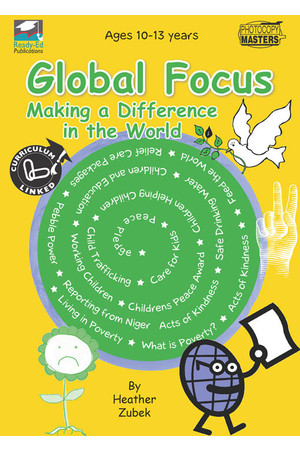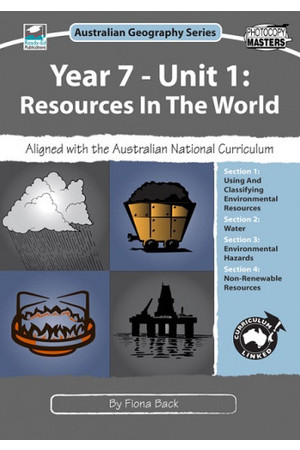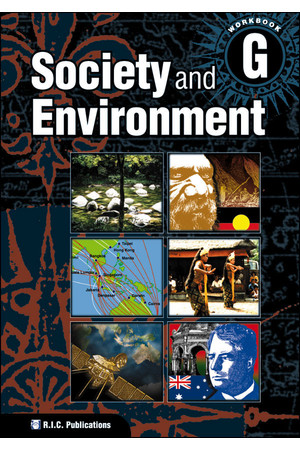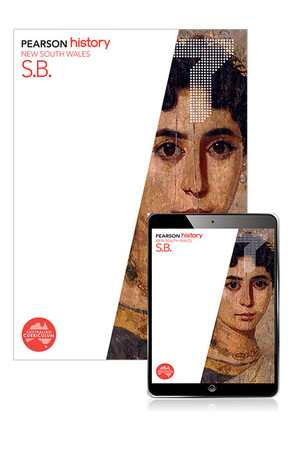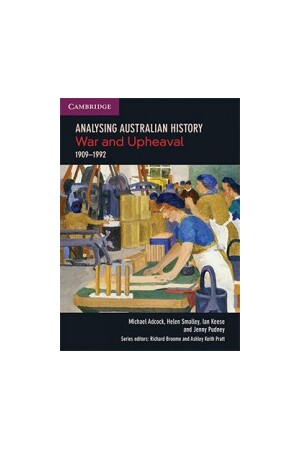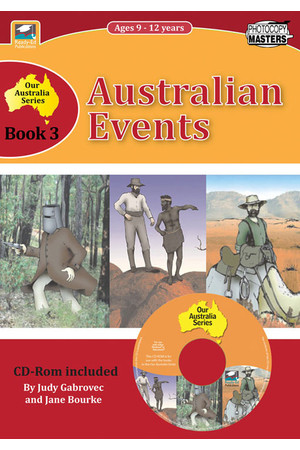Jacaranda Humanities and Social Sciences 7 for Western Australia Third Edition (learnON & Print)
Part of the series Jacaranda Humanities and Social Sciences for Western Australia.
View all products in this series
Jacaranda Humanities And Social Sciences 7 For Western Australia | Third Edition
Developed by expert Australian teachers for ALL students.
Every lesson in the new Jacaranda Humanities and Social Sciences series has been carefully designed to support teachers and to help students by sparking curiosity and engagement through discussion and HASS skills activities.
Because both what and how students learn matter.
Learning is personal
Students: Access lessons tailored to your needs, with interactive content and support to help you progress confidently.
Teachers: Deliver engaging, differentiated lessons with built-in scaffolding and tools to support every learner.
Learning is effortful
Students: Challenge yourself, build confidence, and grow through purposeful practice on Australia’s leading platform.
Teachers: Encourage persistence with tasks that develop resilience and drive meaningful learning outcomes.
Learning is rewarding
Students: See your progress in real time, recognise your strengths, and focus on where to improve.
Teachers: Use rich analytics to track growth and target support exactly where and when it’s needed.
Table of Contents
HASS concepts and skills
1 HASS concepts and skills
1.1 Overview
1.2 Key concepts and skills in HASS
1.3 SkillBuilder - Identifying what you need to know
1.4 SkillBuilder - Collecting, recording and organising information
1.5 SkillBuilder - Selecting relevant information
1.6 SkillBuilder - Identifying patterns and relationships
1.7 SkillBuilder - Translating information
1.8 SkillBuilder - Drawing conclusions
1.9 SkillBuilder - Considering solutions or ideas for progress
1.10 SkillBuilder - Representing information appropriately
1.11 SkillBuilder - Developing effective texts
1.12 SkillBuilder - Reflecting on your learning
1.13 Review
Civics and Citizenship
2 Civics and Citizenship concepts and skills
2.1 Overview
2.2 Civics and Citizenship concepts and skills
2.3 SkillBuilder - Notetaking and writing questions for research
2.4 SkillBuilder - Writing argument paragraphs
2.5 SkillBuilder - Writing a submission
2.6 SkillBuilder - Creating political media
2.7 Review
3 The Australian Constitution
3.1 Overview
3.2 Why we have a constitution and how it can be changed
3.3 Australia's parliamentary system
3.4 The separation of powers
3.5 Inquiry - An Australian republic?
3.6 Review
4 Australia's legal system
4.1 Overview
4.2 The principles of justice
4.3 How courts work
4.4 The presumption of innocence
4.5 Right to a fair trial and legal representation
4.6 Inquiry - Can community action make a difference?
4.7 Review
Economics and Business
5 Economics and Business concepts and skills
5.1 Overview
5.2 Economics and Business concepts and skills
5.3 SkillBuilder - Conducting research
5.4 SkillBuilder - Interpreting and explaining graphs
5.5 SkillBuilder - Evaluating a business plan
5.6 SkillBuilder - Writing a business case study
5.7 Review
6 Consumers and businesses
6.1 Overview
6.2 Needs and wants
6.3 Responding to consumer demand
6.4 Determining prices
6.5 Inquiry - Consumer behaviour
6.6 Review
7 Innovation and enterprise
7.1 Overview
7.2 Types of businesses
7.3 Innovation and technology
7.4 The role of entrepreneurs
7.5 Inquiry - Who are the innovators and entrepreneurs?
7.6 Review
7.6 Topic 7 Post-test
Geography
8 Geographical concepts and skills
8.1 Overview
8.1 Learning matrix
8.2 Geographical concepts and skills
8.3 SkillBuilder - How to read a map
8.4 SkillBuilder - Reading a weather map
8.5 SkillBuilder - Constructing a pie graph
8.6 SkillBuilder - Using topographic maps
8.7 SkillBuilder - Interpreting topological maps
8.8 SkillBuilder - Using alphanumeric grid references
8.9 SkillBuilder - Drawing a climate graph
8.10 SkillBuilder - Creating and analysing overlay maps
8.11 SkillBuilder - Annotating a photograph
8.12 SkillBuilder - Interpreting diagrams
8.13 SkillBuilder - Cardinal points - wind roses
8.14 SkillBuilder - Creating a concept diagram
8.15 SkillBuilder - Understanding satellite images
8.16 Review
9 Water in Australia
9.1 Overview
9.2 Water - An environmental resource
9.3 Groundwater - Connecting people and place
9.4 Water supply, climate change and Australia's water security
9.5 Investigating topographic maps - The value of water in Noosa
9.6 Does everyone have enough water?
9.7 Overcoming water scarcity
9.8 Droughts
9.9 Inquiry - What is the water quality of a local waterway?
9.10 Review
10 Place and liveability
10.1 Overview
10.2 What is liveability?
10.3 What makes a place liveable?
10.4 The world's most liveable cities
10.5 Living in remote places
10.6 Country vs city living
10.7 Liveable and non-liveable cities
10.8 What makes communities liveable?
10.9 Connection to Country
10.10 Investigating topographic maps - Liveability in Badu and Moa
10.11 How places change
10.12 Inquiry - What are the characteristics of liveable cities?
10.13 Review
History
11 Historical concepts and skills
11.1 Overview
11.2 Historical concepts and skills
11.3 SkillBuilder - Historical questions
11.4 SkillBuilder - Chronology
11.5 SkillBuilder - Sources
11.6 SkillBuilder - Continuity and change
11.7 SkillBuilder - Cause and effect
11.8 SkillBuilder - Significance
11.9 SkillBuilder - Communicating
11.10 Review
12 Deep Time History of Australia
12.1 Overview
12.2 The Dreaming and Deep Time
12.3 Country and creation
12.4 Changing landscapes and life
12.5 Living with the megafauna
12.6 Connection to Country and kin
12.7 Trade and technology
12.8 Caring for Country
12.9 How is the connection to culture and Country continuing?
12.10 Inquiry - Should we return ancestral remains from museums?
12.11 Review
13 Ancient Egypt
13.1 Overview
13.2 How do we know about ancient Egypt?
13.3 The importance of the River Nile
13.4 Egyptian society
13.5 The beliefs of ancient Egyptians
13.6 The truth about the pyramids
13.7 Who were Tutankhamun, Akhenaten and Nefertiti?
13.8 The effects of war and trade
13.9 Rameses II - Egypt's greatest pharaoh?
13.10 What should we thank the Egyptians for?
13.11 Inquiry - How have powerful women been recorded and treated in history?
13.12 Review
14 Ancient Greece
14.1 Overview
14.2 How do we know about ancient Greece?
14.3 The Minoans and Mycenaeans
14.4 The Greek 'Dark Age'
14.5 Government in Athens and Sparta
14.6 Everyday life in Sparta
14.7 Everyday life in Athens
14.8 Laws, myths, gods and oracles
14.9 The Olympic Games
14.10 How Greece was changed by wars
14.11 The heritage of ancient Greece
14.12 Inquiry - Did the Spartans really kill their weak babies?
14.13 Review
15 Ancient Rome
15.1 Overview
15.2 How do we know about ancient Rome?
15.3 The rise of Rome
15.4 The growth of the Roman Empire
15.5 The Roman army
15.6 Citizens and rulers
15.7 Slavery in Rome
15.8 Everyday life in the Roman Empire
15.9 Beliefs about death
15.10 Laws and religion
15.11 The fall of the Roman Empire
15.12 The heritage of Rome
15.13 Inquiry - How bad was Emperor Nero?
15.14 Review
16 Ancient India
16.1 Overview
16.2 How do we know about ancient India?
16.3 The geography of India
16.4 The lost cities of the Indus Valley
16.5 New people, new ideas
16.6 The significance of the Mauryan Empire
16.7 Who was Ashoka the Great?
16.8 The social structure of ancient India
16.9 Inquiry - What was behind Ashoka the Great's change in leadership style?
16.10 Review
17 Ancient China
17.1 Overview
17.2 How do we know about ancient China?
17.3 How land shaped China's civilisation
17.4 Everyday life and death
17.5 China and the natural environment
17.6 Confucianism, religions and laws
17.7 Qin Shihuang, the first emperor of China
17.8 The rise and fall of the Han dynasty
17.9 The heritage of ancient China
17.10 Inquiry - How should we judge the legacy of Qin Shihuang?
17.11 Review
Glossary
| ISBN | 9781394359110 |
| Publisher | Jacaranda |
| Product Type | Student Books, |
| Year Level | Year 7, |
Be The First To Review This Product!
Help other Teacher Superstore users shop smarter by writing reviews for products you have purchased.







